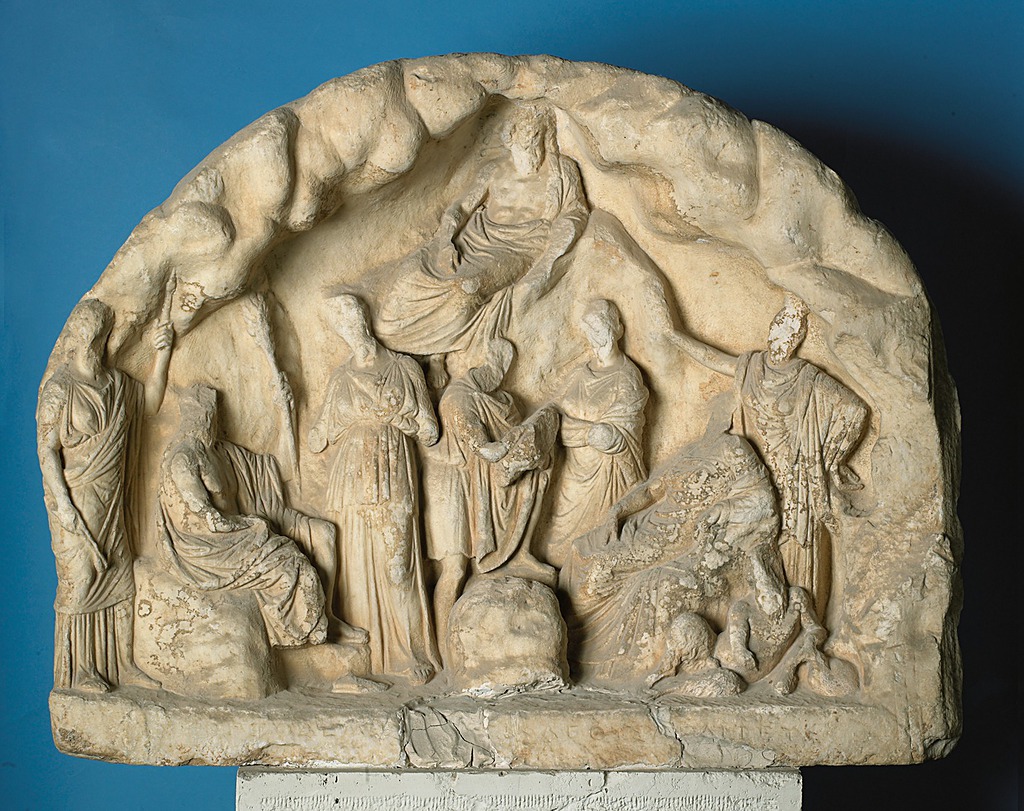Votive Reliefs in the Agora: An Interview with Carol L. Lawton

Inscribed stele with relief and dedication by the cobbler, Dionysios, one of the reliefs mentioned in the book.
Votive Reliefs (Agora XXXVIII) by Carol L. Lawton is the newest volume in our Athenian Agora series. It publishes the Classical, Hellenistic, and Roman votive reliefs found to date at the School's excavations in the heart of Athens. Carol is the Ottilia Buerger Professor of Classical Studies at Lawrence University in Wisconsin. She completed her Ph.D. in Art History at Princeton University and first became a member of the ASCSA in 1970. Her impressive list of publications includes a volume in our Agora Picture Book series, Marbleworkers in the Athenian Agora (AgoraPicBk 27), and articles in Hesperia.
Q: What evidence did you use for this volume?
A: The volume studies 224 reliefs or fragments of reliefs from the Agora excavations. Probably relatively few of the reliefs originated in the Agora proper but wandered into the area from the slopes of the Akropolis and the Areopagos and the hills to the southwest of the Agora and from nearby shrines on the west and north sides of the Agora square. This project attempts to put them into the context of these shrines and sanctuaries in order to see what they can tell us about popular religion in the area.
Q: What scholarship had been done on these votive reliefs previously?
A: Several of the completely preserved reliefs have been the subject of separate studies, and a few were mentioned in reports at the time of their discovery. Others have been mentioned in studies of the iconography of their recipients, but 129 of the reliefs are published here for the first time.
Q: To whom are these votives dedicated? Gods? Heroes?
A: The reliefs are dedicated to both gods and heroes. The deities include many known to have had shrines in the vicinity—for example, Athena, Aphrodite, Asklepios and Hygieia, Demeter and Kore, the Charites, Pan and the Nymphs—but there is also a relief depicting the Anatolian moon god, Men, suggesting the presence of foreigners. The heroes include the ubiquitous Herakles and such minor figures as the heroes Iatros, Kallistephanos, and Strategos, as well as numerous unnamed banqueting heroes and heroines.

Q: Who is dedicating these votives? Citizens? Priests?
A: Very few of the reliefs preserve the names of their dedicators, but from those that do we can identify dedicators ranging from prominent Athenian citizens such as Neoptolemos, son of Antikles of Melite, a wealthy associate of Lykourgos, and Xenokles, son of Apollodoros of Otryne, a hoplite general, to a cobbler named Dionysios, whose dedication depicts him and members of his family in his workshop.
Q: What were the biggest challenges you encountered with this volume?
A: Given the often very fragmentary condition of the reliefs, the first challenge was to identify the deity or hero who was the recipient of the dedication. Then, given that the goal was to contextualize the reliefs, it was often difficult to be sure of their original locations, since none were found in situ and quite a few were in such bad condition that they had been discarded in marble piles on the site.
Q: What questions still remain?
A: We still know relatively little about votive practice in the area. I hope that with continued excavation and with the publication of votive reliefs from nearby excavations such as the Akropolis and the Roman Agora we will eventually have a more complete picture.
Q: You have previously written about marbleworkers in the Agora. How does your work on votive reliefs relate?
A: The excavations have revealed numerous marbleworking establishments in the area of the Agora, not only where one might expect them, in the industrial area southwest of the Agora, but also in Roman times in the ruins of the South Square and in one of the stoas of the Library of Pantainos. Some of the votive reliefs from the excavations are unfinished and presumably came from one or more of these workshops. We tend to think of the Agora as a civic, market, and religious center, but these remind us that the area around it was heavily industrialized, inhabited not only by marbleworkers, but also potters, coroplasts, and metalworkers.
Q: What has been your experience with the ASCSA?
A: I first came to the School as a member of the Summer Session of 1970. Since then, I’ve returned almost annually, as a member, a fellow, and a Whitehead Professor. It is my scholarly home, and I am so indebted to its directors, faculty, staff, and members for their inspiration, collaboration, and assistance in the work I do. I’ve formed lifelong friendships there; I met my husband there!
Q: What are you working on now?
A: I am still working on votives found in the Agora excavations, the dedications to the Mother of the Gods, which mostly take the form of marble statuettes and naiskoi. There are almost 150 of them, more numerous than stone votives to any other deity, and they present many of the same contextual challenges as the votive reliefs. I am also collaborating with Christopher Pfaff on the publication of the architectural sculpture of the Classical Temple of Hera in the Argive Heraion.
___________
Agora XXXVIII
248 pp, 12 col figs, 3 col and b/w plans, 60 plates
Cloth, 9" x 12"
ISBN: 978-0-87661-238-5
Votive Reliefs (Agora XXXVIII) can be purchased from our distribution partners: click for information on how to order from Casemate Academic (in North America) or from Oxbow Books (outside North America).